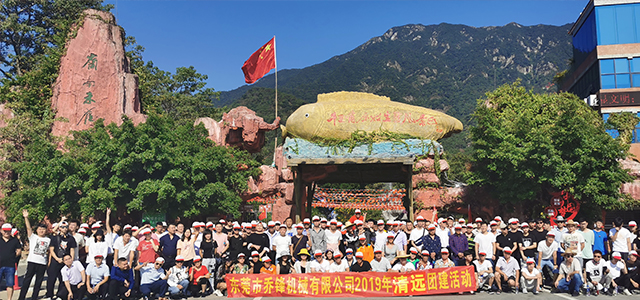When it comes to smart people, most of them have a methodology. McKinsey, which owns 70% of the clients of the world's top 100 companies, has not only been praised for its professional consulting services, but its methodology that has been spread over decades has also been imitated and learned madly. The seemingly simple method, but the tricks are all stunts.
McKinsey has a 7-step method to solve the problem:
1. Master the real problem
2. Organize the problem
3. Collect intelligence
4. Make a hypothesis
5. Verify hypothesis
6. Think about solutions
7. Implement solutions
This is a general problem-solving framework. Even if we encounter new problems in an unfamiliar environment, we can use it to carry out our work. But the framework itself does not allow you to solve a problem effectively.
For example, you know that the content of a speech should be designed according to the structure of ramps, discoveries, and desserts, but you may not be able to design the structure of a speech; for example, you know that the MVC pattern can well separate data and presentation , But it’s hard to tell whether you use it well in development.
If you want to be able to use a framework to solve problems quickly, you also need to open up a joint:
Through practice, master the skills and habits of using the framework efficiently.
"McKinsey's Work Methods: 39 Work Habits Managed by McKinsey", from this perspective, summarizes 39 work habits in different categories around the 7-step method of problem solving. Help you develop habits, control the framework, and solve problems. I have selected 10 and recommend them to everyone.
The first step in McKinsey's problem-solving process is to "start from scratch" to find the real problem.
Because often the problem that the client gives us is not the real problem.
For example, someone asks you "Why are the employees in the department not motivated?". It is very likely that the problem is not that "employees are not motivated", but that managers cannot communicate well with subordinates and cannot effectively motivate them.
Therefore, we must jump out of the surface of the problem, avoid the direct response mode of processing, and think more about what the problem is.
It is very important to keep thinking from the original point. Because if you get the real problem wrong, all your efforts will be in vain. Weinberg's "Are Your Lights On" also elaborated on this point.
This is the habit advocated by our idiom "precaution". But this book makes it concrete and methodological, and it is easier for us to know how to do it. Look at the picture below to make it clear:
"Empty" refers to the "fact" of "what is the current situation". If "the sky is full of dark clouds, then it will rain soon".
"Rain" represents the "explanation" of "what is the meaning of the current situation". In other words, what conclusions will be drawn based on the facts. The condition that it may rain at any time gives an explanation that if getting wet will affect the mood.
"Umbrella" means the actual action that should be taken after understanding the facts and explanations, that is, the "solution." As long as you go out with an umbrella, you won’t get wet.
The so-called PMA (Positive Mental Attitude) refers to "maintaining a positive working attitude" at all times. Only find ways to succeed, not to find reasons for failure, and concentrate all energy on completing the work.
The example at the beginning of this habit is easier to arouse the disgust of employees. But the cruel thing is that it is right.
If you are a young man with only a few years of work experience, then the communication with your boss is basically "serious obedience". In this way, the quality and efficiency of your work will be improved.
Respect your boss, and absolutely obey, be a good and obedient employee. No matter what the boss says, just keep answering "yes".
"but……"
"Hey?"
"but……"
"Difficulties!"
"Can't do it."
From now on, delete these answers from your dictionary. Answer "yes" honestly, and then follow the boss's instructions to work, concentrate all energy on the work, and strive to achieve success beyond the expectations of the boss.
"A sincere, upright, and clear person" is invincible.
Some people may think, isn’t this the same as a slave?
That shows that he does not understand the phrase "a positive attitude is inherently valuable".

On August 29, 2011, what Jack Ma said when sending an internal email was the same logic:
People who have just joined the company for less than a year, don't write a strategic report to me, don't talk about Ali's development plans... whoever mentions, who leaves! But after you have been an Ali for three years, I will definitely listen to what you say. We like small suggestions and small improvements... We are grateful for your every small improvement action.
In the book "Letter to Garcia", there are similar views.
I often receive questions like "How to build a good relationship with the leader", "Do you want to flatter me?", "Why are my colleagues who are not as capable as I only have a relationship with the leader, but have more salary increases than me?"
This habit can answer such questions. The subordinates loved by their bosses all have one thing in common, that is, they have the ability to find out the type of boss.
For people with poor working ability, no matter what kind of boss they follow, they are always "self-centered". As a result, the cooperation between him and his boss will be very out of sync, making it difficult to make progress in the work.
In real work, we should observe what type of boss belongs to from a neutral perspective, and then cooperate accordingly. In this case, your work will definitely become very smooth.
The book distinguishes the type of boss from two dimensions: personality and task management style.
1. From the perspective of personality, identify whether the boss is "emotional or rational."
This division follows the third personality dimension in MBTI. For example, my MBTI code is INFP, and the third letter is F, which is emotional; the third letter is T, which is rational.
If you know the results of your boss’s MBTI test, it’s easy to tell the difference. If you don't know (high probability), you can only speculate by observing his behavior style.
Emotional bosses are straightforward, emotional, vigorous, empathetic, easy to move, prefer sensibility when making decisions, and pay attention to people's feelings.
When communicating with emotional bosses, focus on emotional performance and use more words that resonate with emotion.
For example, when you talk to him about mortgages, you are too stressed, upset, anxious, and often feel powerless and depressed. He may be easier to feel.
For example, if you want to take time off to participate in your child's sports meeting, describe how much your child expects you to appear. He is also likely to readily agree, and will chat with you a few words.
A sensible boss, self-control, value theory, thorough preparation, calmness, hate excuses, and waste of time; likes logical analysis and reasoning, and emphasizes reason to convince people; often think that certain things should be done logically. You may think he is indifferent and unkind.
Communicate with this type of boss, you don’t need to chat, you don’t need to be close, and you don’t need to show your rich feelings. These are not only useless, but also lower his evaluation of you.
For example, if you say that you have a lot of troubles at home and you can't work overtime, he will often coldly think that it is your own business and it is your responsibility.

For example, there was a serious data error in the report you sent him this morning. You explained that it was too tired to work overtime until 3 am last night, and I was a little tranced in the morning. He will not accept your explanation at all, instead he will think that this person is not responsible and responsible and will only make excuses.
Straightforward, clear-cut, logical, and well-founded. This is the way that a rational boss likes. It is a good strategy to change the way you communicate with him and actively cooperate.
2. From the perspective of task management, it is necessary to identify whether the boss is "individual or compound."
Individual bosses will basically focus on one job and prefer to manage tasks in a serial manner. One job will not start until the other is over.
When reporting to a single boss, pay attention to discussing and reporting on one job. Don't stay around for a while, it will easily arouse his anger.
Compound bosses are good at multitasking in parallel, are not afraid of being interrupted, and like to do multiple things at the same time like an octopus.
When you meet this type of boss, you can ask questions and discuss with him. He will not be bothered. However, he is easy to forget. What you mentioned today may be forgotten tomorrow. Many tasks he handles are also likely to be lost.
At work, if we know our type. Find out the type of boss, you can use your strengths while working with the boss.
Once, a colleague of mine approached me and said, "Boss, do you have time? I want to talk to you." I said yes, so when we got to the meeting, he told me he was leaving.
I'm so embarrassed, I have no preparation. Another time, I wanted to find a colleague from another department to discuss an architectural design issue. I walked to his desk and said, "XX, do you have time in the afternoon?"
He suddenly raised his head, his eyes were wary, and he asked stiffly: "What's the matter?"
These are two very bad beginnings. If you can express clearly what the problem is and how much time it takes, it will be easier for others to cooperate with you.
For example, if my colleague who is about to resign says, "Boss, take up 10 minutes of your time to talk to you about resignation." I can know what he wants to say to me, and I can arrange time to have a good chat.
For example, I asked colleagues from other departments to discuss the structure problem, and used "XX, there is a CMS structure problem. I want to take you 10 minutes to discuss it, can I?" He didn't react so much when he started with this sentence.
Your manager tells you: "The product has a requirement, please take a look." You accepted the task, discussed it with the product manager, and then you went to work, and started to modify the code...
After three days of doing it, the manager came to ask you: "The version that Zhou Yi said should be released today. How is it going?" You looked dumbfounded: "Ah?! Didn't you show me the new requirements? Me? The requirements of the product are being fulfilled, and that version has not been available yet."
The manager has a black line on his face, so let's go right away. Do you think you are wronged? Obviously you let me see the new demand wow! However, in fact, you are not wronged at all.
Because you haven't figured out your leader's intentions, and you haven't confirmed your goals with your leader.
When we receive a task, we must understand three things:
1. Background and intention
2. Purpose of work
3. Deadline
These must be confirmed before starting work, and working hours will be arranged after the problems are clarified. Only in this way can work efficiency and quality be greatly improved.
In addition, in the process of investigating, you should always confirm the direction of the work to your boss and whether there is any deviation.
If you don't understand the intention of the task delegate, you start to smash it according to your understanding. The result is often a word from the leader, and your job will start all over again.
Scenes like just entering university, just entering the workplace, just entering a new company, or just joining a certain group, may all make you introduce yourself. Your introduction may look like this: "Hello everyone, I am the White Lady, please take care of me."
Excuse me, is such an introduction useful?
It's useless. Because there is no other information in this introduction except the name, others can't find what you have in common.
If it’s changed to this: "Hello everyone, I’m Bai Niangzi. My home is by the West Lake in Hangzhou. I graduated from Zhejiang University. I like to read novels. Li Bihua’s "Green Snake" is my favorite. I also like Sichuan Opera Changing Faces and Yoga. , I also like to make cakes by myself, and I also like to play "Glory of the King". I hope to communicate more with you."
Is it better? In the new version, the personal hometown, alma mater, hobbies and hobbies are revealed, and a connected landing site is constructed. In this way, those who like yoga can talk to you about yoga, and those who like to play "Glory of the King" can discuss equipment with you...
When you connect with others because of a certain commonality, the subsequent interaction will be more natural and smooth.
I saw a question in a WeChat group yesterday:
There is a great technical man in the team, and the design is always difficult to achieve. But he is very insistent, no one says it's useless, what should I do?
Someone asked me:
The leader came from the line of business and did not understand technology. His arrangements are often unreasonable, leading to inefficiency. How can I remind him that it is appropriate? Just say that he will be very upset.
Similar to this kind of problem, we will encounter every day in the work. Habit 26 provides a great way to properly deal with these problems.
The idea of this habit is: use questions and questions to guide the other party to see the results for themselves.

Let’s use the examples in the book. The two questions I mentioned earlier can be used as exercises. Write the solution you think of in the message at the end of this article.
A customer asked a question: "White cups can't sell. What should I do?" You know that white cups are very competitive in the market, and different colors should be introduced.
If you say directly: "I regret, I think there is no market demand for your company's white cups. These data can show..." Hearing you say this, the other party will definitely be very embarrassed-because his job has been completely denied.
But if you try to ask the following questions:
Your company's insistence on producing white cups is great, so how does the market react to white cups?
What color cup do customers like?
Which cup is the best selling cup now?
If you are a customer, what kind of cup would you like?
When do you use the cup?
What do you often drink when you eat? What container is used when drinking?
Put your own opinions and assumptions into it, and let the other person think about the answer to the question. He can often see the problem for himself.
Okay, let's give another example.
The company’s news app requires users to register with their mobile phone number before they can browse the news. You think this is unreasonable. You should allow anonymous use or log in with WeChat.
If you go directly to the product manager and say: "This design is simply brain-dead. Users can't see anything and it's impossible to register with a mobile phone. Besides, mobile phone registration is inconvenient. It's annoying to send a verification code or something."
Assuming you are a product manager, how would you react when you hear the developer say this? Embarrassment, retort, anger, anger... will be there.
If you ask the product manager a question: "The first time you used Toutiao, did you register with your mobile phone?" He might realize that his design is inappropriate.
McKinsey’s "good bosses" have three things in common:
1. Recognized subordinates
2. Resonate with subordinates
3. Motivate subordinates
Regarding how to recognize subordinates, I will extract the original text first:
To maximize the potential of subordinates, the best way is to "recognize" subordinates. Although it is similar to "praise", it is actually quite different.
The so-called "recognition" refers to the recognition of the person's existence and understanding of the person's superiority.
The "praise" should be carried out when the subordinates meet their expectations, that is, there are conditions.

Compared with conditional "praise", people pay more attention to the "recognition" of their own existence. Once recognized by others, it is easy to be energetic and grow quickly. The boss who makes the subordinate grow up is the boss who "recognizes" the subordinate.
The description of recognition here reminds me of "unconditional love" for children. The so-called unconditional love means that your love does not happen because a certain condition is met.
For example, if your child has good grades, you can stop him. If your child fails in the exam, you don’t love him. Then your love for your children is not unconditional, but based on good grades. The child cannot feel your love for him.
You know, you are stunned by the child, not because of what he has achieved that you love him.
Similarly, to "recognize" your subordinates, the key is to let them know that you "recognize" his existence itself.
It's really hard, isn't it?
The book provides a method that you can try: list at least 10 advantages of each subordinate and convey these advantages to the subordinates themselves.
The good teacher mentioned here corresponds to the mentor in English. He may be such a person (one or more of them):
People who listen to themselves
Someone who can overlook himself
Someone who inspires himself
People who stimulate their potential
A person who provides excitement
Remind yourself of the wrong person
People who think about hypotheses and solutions with themselves
You must find your own "good teacher" in the workplace. He can provide you with feedback so that you can face problems better and grow faster. If you have read "Deliberate Practice", you must know the importance of feedback-without feedback, there is no growth.

In Habit 36, three conditions that a good teacher should meet are given:
No one is like
Intuitive
Strong professionalism
Then I also suggested that it is best not to find direct supervisors and seniors as mentors. I guess this is because there are interests in work and it is easy to lose objectivity.
Former bosses or former seniors, humble and trustworthy people are the best candidates for mentors.
Don't worry that others will not be your mentor. Because if you maintain this relationship for a long time, your life will become more colorful.
There are three ways to bridge the gap between knowing and doing:
practice! practice! practice!
Further reading
Ni Yili, McKinsey's senior managing partner and president of McKinsey Greater China: "How to disassemble McKinsey's way of thinking?"

Many people think that we have a set of standardized and standardized thinking, and McKinsey thinking has always been common in various books and reports on corporate management. Indeed, every person who enters McKinsey will undergo a very complete analytical thinking training, which is what we often call the "seven-step McKinsey way of thinking". This way of thinking includes:
Clearly state the problem to be solved-the problem should be specific, not general, not a non-factual listing or an indisputable claim, and an actionable solution to the problem can be taken;
Use the logic tree to analyze the problem;
Use the funnel method to remove all non-critical issues;
Develop a detailed work plan-work in an orderly manner, using the 80/20 Rule (The 80/20 Rule, called "Pareto Rule") to deliver on time;
Some principles should be followed when conducting critical analysis, including choosing simple problem-solving methods as much as possible, avoiding complexity, and finding obvious things;
Comprehensively analyze the survey results and construct an argument;
State the ins and outs of the matter, prepare a story diagram, draw the complete structure of your argument, and concatenate the information text above each chart to form a logical and persuasive story.

Among these methods, MECE (Mutually Exclusive Collectively Exhausted) is a basic principle of McKinsey's thinking that is known to the outside world. It refers to "independent and completely exhausted" when analyzing problems, that is, for a major issue, Able to achieve non-overlapping and non-missing classifications to effectively grasp the core of the problem.
Extended reading: How to have efficient logical thinking?
Source: Zhang Liangji (ID: zhang_liangji)
1.Be MECE
MECE is taken from "Mutually Exclusive Collectively Exhaustive", which means mutual independence and complete exhaustion." Barbara Minto, a senior consultant of McKinsey, proposed this concept for the first time in the "Pyramid Principle", which became the strategy consulting industry. One of the important principles.
Usually, the use of MECE starts from a top-level problem and decomposes it layer by layer. First list the problems you need to solve, then divide the problems into sub-problems, and ensure that they do not overlap and interfere with each other. At the same time, make sure you list all the sub-problems you can think of.
In practice, you just have to keep asking yourself two questions:
1. Have I taken into account all possible factors, are there any omissions? If so, look for it again.
2. Are there any overlaps between these factors? If so, perform deduplication.
For example, for example, the question you are encountering now is: "Should I change jobs now?" Then the breakdown of this question can be shown as follows:
2. Induction and deduction
These are two basic logical laws of cognition and thinking. In simple terms:
Induction is to list things with the same attributes one by one, and then find common points.
Deduction is to arrange the factors that influence each other in the order of causality, time sequence, and importance, and then find a breakthrough.
The dragon gives birth to the dragon, the phoenix gives birth to the phoenix, and the mouse’s son will make holes.
Tai Chi produces two instruments, two instruments produce four images, and four images produce eight trigrams. This is a deduction (starting with Tai Chi and working backwards).
You can split all the problems in your work by deduction or induction. I like to call this process "deconstruction." Inductive deduction and the aforementioned MECE are often used together. In the process of inductive deduction, adhere to the principle of MECE, which can decompose complex problems into a variety of single factors. This process is like peeling off a cocoon and breaking a mess. Articles are smooth.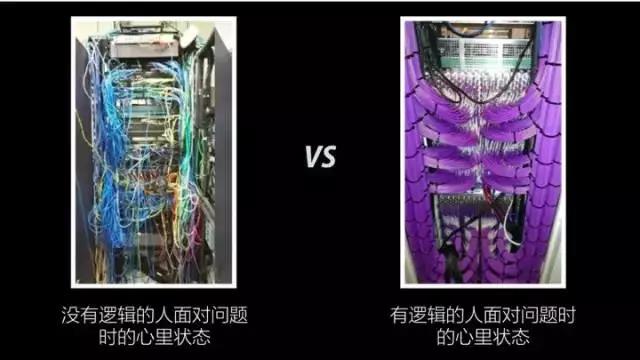
The following is a thinking outline that I will follow when thinking about problems, you can refer to:
1. What is the core problem?
(There can only be one, if there are many, find the most important one)
2. What is the background of this question? (Ins and outs, historical reasons)
3. What are the characters and factors related to the current problem? (Remember the MECE rule, use induction, and list them all together)
4. What are the key causes of this problem?
5. What are the secondary reasons?
6. What are the ways to solve this problem? (Using induction, write out all the possibilities. Use deduction to find the specific steps of each method)
7. To solve this problem, what conditions or resources do you lack now?
8. How to make up for these lack of conditions?
9. What is your time plan, what do you do first, then do what, then what?
10. The last step, just do it.
Example: You are now an assistant, and your boss just told you that you need to help her book a flight to Beijing on Sunday, but you find that almost all the tickets for Sunday are sold out. At this time, you still have three emails that you haven't sent, and there is another meeting to attend this afternoon.
1. What is the core problem? (There can be only one)
The boss is going to Beijing on Sunday, but the flight tickets are all booked.
2. What is the background of this question? (Ins and outs, historical reasons)
The company will have an important publicity event in Beijing on Sunday, lasting two days, so the boss must arrive before Sunday. In addition, the boss has a meeting in the morning on Friday, and it will be fine in the afternoon. So Friday afternoon to Saturday is the time when the boss can go to the airport.
3. What are the characters and factors related to the current problem? (Remember the MECE rule, use induction, and list them all together)
You are the only assistant to the boss, and you alone are responsible for this matter. The boss has to fly, so the key factor is the flight schedule of major airlines to Beijing on weekends and the remaining seat information.
4. What are the key causes of this problem?
You learned that it was too late and missed the best time for booking.
5. What are the secondary reasons?
Recently it is the peak tourist season, and there are many people going to Beijing on weekends, which has caused a tight flight. But rescheduling is impossible.
6. What are the ways to solve this problem? (Using induction, write out all the possibilities. Use deduction to find the specific steps of each method)
A. Book your own tickets. Spend an afternoon sorting out the information of all Chinese airlines and travel websites, and make a statistical table of the remaining seat information on flights to Beijing on Friday and Saturday, including take-off and landing time, cabin class, and airport information , The ticket price, and then record this information.
B. Entrust your friends in the travel agency to help search for the final flight ticket, and also record the information according to the take-off and landing time.
C. Prepare alternatives. If all the tickets to Beijing on Sunday are booked or the time is not good, then search the timetable of the high-speed rail instead, and also record the time, train station and other information.
7. To solve this problem, what conditions or resources do you lack now?
time. Because I missed the best time for booking, it is necessary to search the remaining flight seat information on the Internet as soon as possible. You can't be too busy, you need help.
8. How to make up for these lack of conditions?
Ask colleagues or interns in the same group to help, tell them the urgency of the matter, and ask those who are free to help you search, and then you will summarize the information.
9. What is your time plan, what do you do first, then what, and then what?
Today is Tuesday. You still need to send three emails in the morning, and you have an urgent meeting to attend before two o'clock in the afternoon. You have time after three o'clock and before get off work. So now entrust a colleague to help search for flight information, and after three o'clock you will continue to do the next work and summary.
10. The last step
Remember, when you are confident about presenting your solution to your boss, you can never be a sentence like "Boss, I will book you a ticket for Friday at 8 pm".
Believe me, if you answer that way, your assistant won't last long.
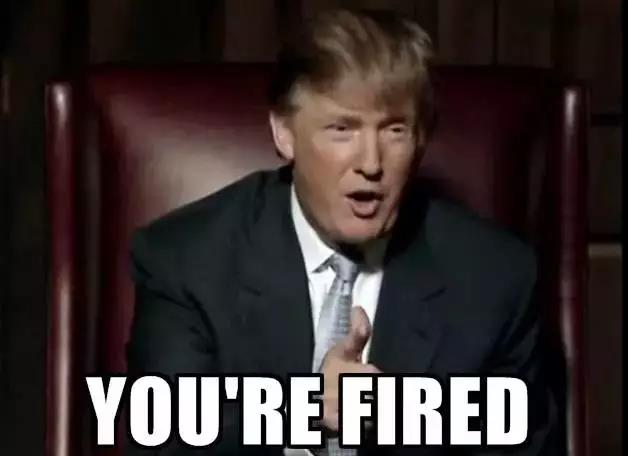
The smart assistant will first make the previously collected information into a simple and clear form, including all flight departure times, airports, airlines, etc., and high-speed rail as an alternative. When she presents this form to her boss, she will say:
Boss, based on my research, I think the best time for you to go to Beijing on the weekend is 3pm on Friday or 3:30pm on Saturday. Because you have an important meeting on Friday morning, after the meeting you rushed to the airport just in time to catch the plane, and after landing in Beijing, you arrived at the hotel just in time for dinner. On Saturday, you usually get up late. If you take off at 3:30 in the afternoon, you can have a good lunch at noon. The time from your home to the airport is also just right, not too rush. The airlines of these two flights are also the ones you used to take before. I believe you will be satisfied with their services. If you think these two times are not good, other flight times are more embarrassing, so I also prepared an alternative plan, if you do not recommend taking the high-speed train...
Haha, don’t think it’s easy to book a plane ticket for the boss, and it takes a lot of effort to do it! This is the lesson of blood and tears. Not to mention the much more complicated issues at work.
But it is inseparable. When you have consciously cultivated such a logical method of thinking about problems in your daily work, you will form a habit over time, and you will be able to analyze and solve problems efficiently in the future.
3. Let's talk about the conclusion first
McKinsey has a well-known elevator theory: sell your plan to customers within 30 seconds of entering the elevator. No one will listen to irrelevant nonsense in such a short period of time, so the first sentence is to convey your core point of view: what is our plan and why it is the best choice.
Remember to follow the principle of total score, first throw out the core point of view, that is, "what should we do". This may be a few sentences, but these few sentences have condensed a lot of your thinking and spent a lot of time on your research and analysis. After expounding the core point, the next step is to explain, that is, "why do this". Just like writing a paper, first the core thesis, then the sub-thesis supporting the core thesis, and then the second-level sub-thesis, in descending order. As shown below:

"Deduction, induction and MECE" is your analytical thinking process; "conclusion first" is your presentation method after thinking. The person who first talks about the conclusion can grab the attention of others from the beginning, and then demonstrate the correctness of the conclusion in a progressive manner, so that the audience will not lose their way.
Such examples abound in daily work. such as:
Conclusion: I should switch to sales
Argument: First of all, the current job income is not high, and living in first-tier cities is relatively difficult (low economic income). Secondly, my current job is a clerical job. I sit in the office and deal with documents every day, and I have fewer opportunities to interact with people. It is not suitable for my personality (subjective reasons). Third, I hope to do more challenging jobs in the future, which can help me grow quickly. And sales are undoubtedly very challenging. Although the salary will not be much higher than it is now, it can be exercised a lot (emphasizing future growth). Finally, there are already two good big companies that are short of sales, and they have also expressed strong interest in me (emphasizing that there is already a chance to get closer to themselves).
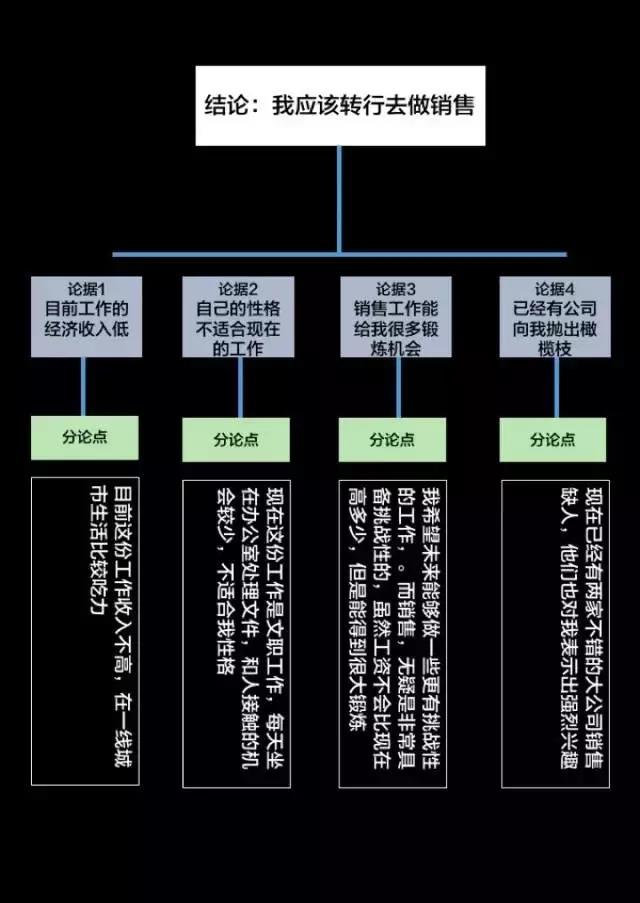
Conclusion: I decided to eat salad at noon
Argument: First of all, I ate hot pot yesterday. After eating it, I had vomiting and diarrhea, and my stomach was not good. Today I can no longer eat heavy flavored food (subjective factors). Secondly, I have been working out to lose weight recently. This week I have eaten big fish and meat for three consecutive meals (subjective factors). Third, there is an important meeting at one o'clock this afternoon. If you eat other food, you may have to queue for a long time, and there is not enough time (emphasize objective conditions). Finally, I heard that the western restaurant downstairs has launched several new salads. After reading the introduction, I am very interested in trying them (subjective factors).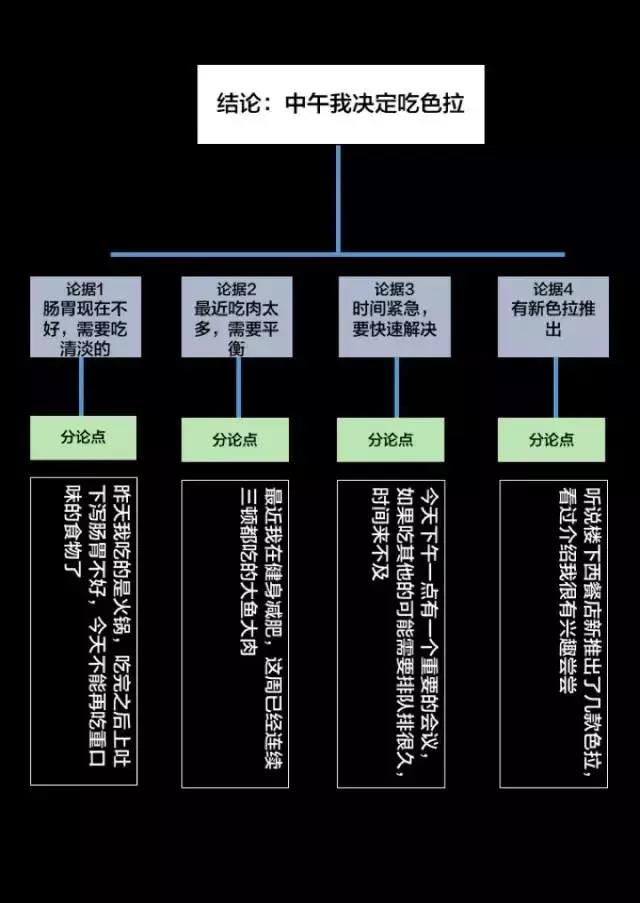
Conclusion: I should rent this house now
Argument: First of all, this house is not far from our company, and the subway is only three stops away (emphasize the distance). Secondly, the landlord of this house is very good, and the electrical furniture rationed to me is the latest one (emphasis on living conditions). Third, the rent is very reasonable. Compared with the surrounding houses, his price is a bit more expensive, but it is fair (emphasize the price). Finally, although the living facilities around this house are not very convenient, there is a big supermarket one kilometer away, so I can buy daily necessities once (although it is inconvenient, but it can be overcome).
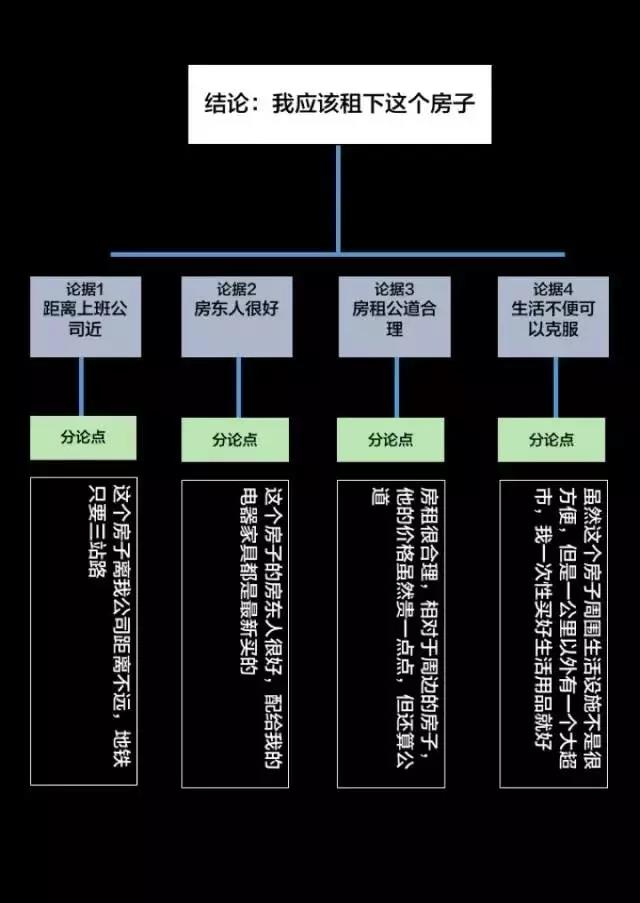
No matter who it is, they will like this method of presentation. This is why, when you report to your leaders, they will never listen to your lengthy explanations and analyses. They will only listen to your conclusions or solutions. When they are interested, they will ask for details. When they are busy, they only need to hear the most important things.
And when you develop this habit, trust me, your leader will like to listen to your report very much, because he will think "you and I are people on the same channel". Don't choose who you choose when you get promoted!
4. Cultivate insights
This is my personal favorite experience. The word Insight is used a lot in the advertising industry. My understanding of this word is: the cause of the thing, the cause of the cause, the cause of the cause of the cause.
In other words, as mentioned at the beginning of the previous article, "People who spend half a second to see through the essence of things, and those who spend their entire life unable to see the essence of things, are destined to have completely different destinies."
What you need insight is the nature of things.
But it is a pity that there is no theory or model to learn from for insight into this thing. I prefer to attribute it to the habit of thinking hard in my daily life.
When you first started working, you were working on a project in a team. What you can think about are the rules, similarities and differences between different projects, common practices and special practices, why this is done, what are the driving factors behind it, etc.
When your position is promoted, your subordinates will start to manage people. At this time, you can think about how to get along with each other harmoniously, what kind of personality you are, what kind of person you are suitable for working with, and how to mobilize Start the enthusiasm of the people working and so on.
After you have been immersed in an industry for a long time, you may have your own understanding of the industry. At this time, you can think about whether this industry is suitable for you, what are the problems in this industry, and why such problems arise. , What will be the future development of this industry and so on.
The things you need to see are different depending on your position. At this time, you need to open your mind. Don't set limits for yourself. Think divergently:
1. What is the status quo of things?
2. Why is this happening, and what are the reasons for this?
3. Which reasons are objective factors and which are subjective factors?
4. If one of these factors is changed, how will things develop?
5. If you change two of these factors, what will happen?
Einstein once said: "logic will get you from A to B, imagination will take you everywhere."

